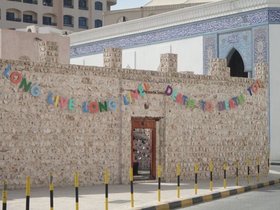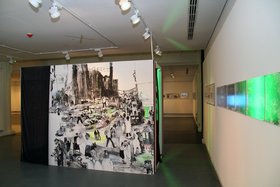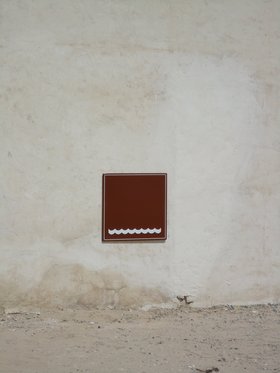Essays
10th Sharjah Biennial
Sharjah, UAE, 16 March – 16 May 2011
The UAE's sole biennial, the Sharjah Biennial organized by the Sharjah Foundation celebrated its tenth edition, entitled Plot for a Biennial against the backdrop of recent revolts in the Arab world. The biennial was guest curated by Abu Dhabi Guggenheim curator Suzanne Cotter, creative director of ArteEast, Rasha Salti and associate curator Haig Aivazian a Chicago based artist/curator, with Jack Persekian retaining his role as overall biennial artistic director. Thematically this year's biennial loosely drew on keywords, which included, but were not limited to: Treason, Necessity, Insurrection and Corruption and despite Cotter's aim of defining a biennial that 'sketched out a porous terrain that endeavour[ed] to escape from the dialectics of art and politics,' as stated in her catalogue curatorial statement, the exhibition inevitably and ironically created a junction with recent political events reverting back to art and politics in contemporary art.
Jumpstarting the biennial was the March Meeting, a series of short presentations by artists and arts professionals form the MENASA region spread over three days. Now in its 4th installment, this year's March Meeting left many attendees disappointed with the lack of political discussion, especially given the biennial's connotations. Inspired by the spontaneity of the region's uprising a small group of international visitors decided to stage a small-scale manifesto by holding up handmade leaflets with the names of Bahraini protesters who were killed. This act led to the interrogation of its initiators along with biennial curators Salti and Aivazian, who were not part of the 'performance', making it unclear why only two out of three curators were chosen by the local police. All arrested were later released without charge. A parallel intervention was also performed by the collective Slavs and Tatars who handed out green balloons to international visitors as part of their satirical project A Monobrow Manifesto (2010).
Back within the solid walls of the Sharjah Art Museum, which hosted the biennial's main bulk of the exhibition consisting of works on papers and canvases, was a standout piece by Khalil Rabah, Art Exhibition- Ready Made Representations (2011), which gathered a collection of 50 photorealist oil paintings from exhibitions of global Palestinian art from 1954 to the present day. These works were segmented into generic categories, which are at the core of Rabah's practice of questioning the trajectory of modern and contemporary Palestinian art within a social and political context.
Walking through the halls of the museum, which are traditionally and individually sectioned, one could see whimsical modernist scenes of heavily hued oil painting series Still Life-Landscape (2004) and Celebration of the Absents (2010) by Ziad Dalloul, contrasting with Anna Boghiguian's extravagant yet moving drawings and paintings from her large multidisciplinary installation The Simple Affair that Moved the World (2010-11), boldly depicting the movement of people facing corrupt governments and ultra-capitalist ideologies.
A walk away from the museum is a large sidewalk transformed during the 9th Sharjah Biennial into a football ground where local men and children played football and cricket. This has now been re-appropriated by Khalil Joreige and Joana Hadjithomas as a space for displaying their Cedar 4, a mock reproduction of a space rocket, which is part of their multidisciplinary project Lebanese Rocket Society: Elements for a Monument (2011) based on their research into the Lebanese Rocket Society - a group of scientists from the Haigazian University in Beirut who were conceiving and launching rockets for the exploration and study of space during the 1960s.
Other works of note scattered around the Arts and Heritage vicinity of the city included Bouchra Khalili's eight video projections and a printed map installation, The Mapping Journey Project (2008-11) inspired by post-structural theorist Michel Foucault's The Life of Infamous Men. The work cleverly reveals the underground and hidden geographies of the Mediterranean region through conversations on the mobility struggles of people within this geographical area. Elsewhere, Hrair Sarkissian's photographs of deserted Execution Squares (2008) created an eerie and poignant atmosphere of contemplation for audiences. Also playing on the concept of absence was Walid Sadek's mixed media installation The Labour of Missing (2011) that offered a derelict space of reflection on the subject of loss.
Plot for a Biennial showcases a remarkable variety of music and performance and mediums, ranging from drawing to site-specific installations, but the privileged medium is undeniably film. Close to 28 hours of videos – excluding the cinema programme selected by a curatorial team that included Solange Farkas and collective, What, How and for Whom (WHW), shown in cinemas across the city – made for a mentally and physically challenging supplementary exhibition, making the rift from the curatorial narrative more evident. An astonishing film work was the suspense driven 70-minute looped film by New York/ Dhaka based artist Naeem Mohaiemen, The Young Man Was No Longer A... Part 1: United Red Army (2011), based on archive footage of the 1977 hijacking of a Japan Airlines flight that landed in Dhaka. In his version of events, Mohaiemen masterfully evokes the 'collaboration' between the negotiator and the hijacker within the context of 1970s failed utopias, which was highlighted in the protagonists' montage-like dialogue, which was manipulated through re-scripting.
Complimenting exhibition and film, biennial artists were also invited to work collaboratively to produce publications; one example included Manual for Treason (2011) a set of six multilingual booklets consisting of visual, textual and discursive interventions by writers and artists. A substantial catalogue was also produced that provided an insight into the biennial's premise and artists' projects.
Since its inception in 1993 the Sharjah Foundation has supported and awarded artist prizes for the best work, thus providing support to a number of young and emerging artists. This year early career artist Rayyane Tabet was a recipient for his process driven piece Home on Neutral Ground (2011), a three part installation project about a singular cricket stadium. Other recipients included Rania Stephan and Jalal Toufic.
Overall, the biennial's works diffused a romantic nostalgia for fragmented utopian ideologies and a desire to communicate with surrounding realities. However, from a curatorial perspective it merely succeeds in loosely engaging with its set framework, which opens up to wider questions about the process of curatorial practice within various national, geographic and thematic contexts – and in light of artistic director Persekian's dismissal a few weeks after the biennial opening over the alleged political significance of an unnamed work, artists and curators are faced with the dichotomy of making concessions when participating in such contexts.








